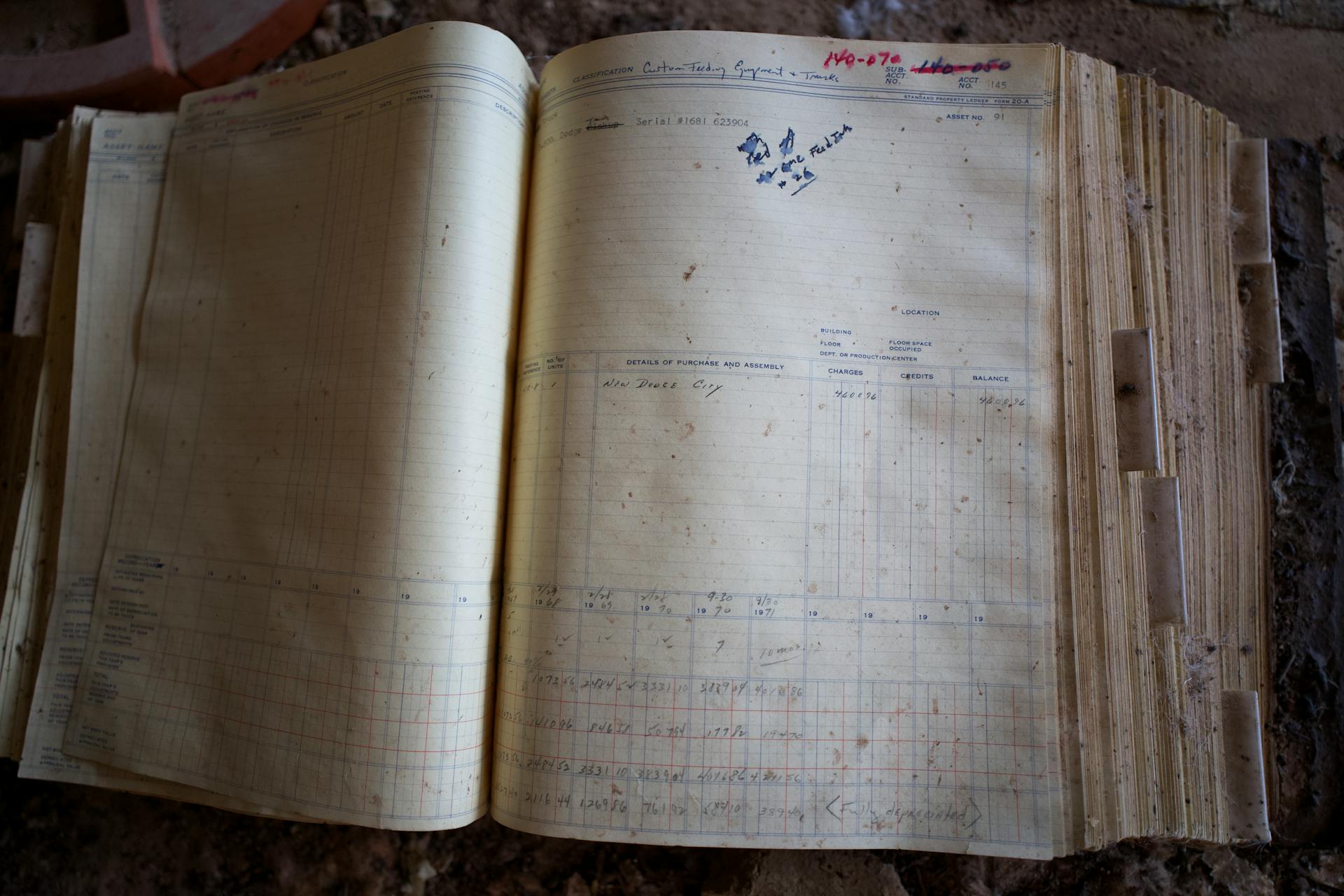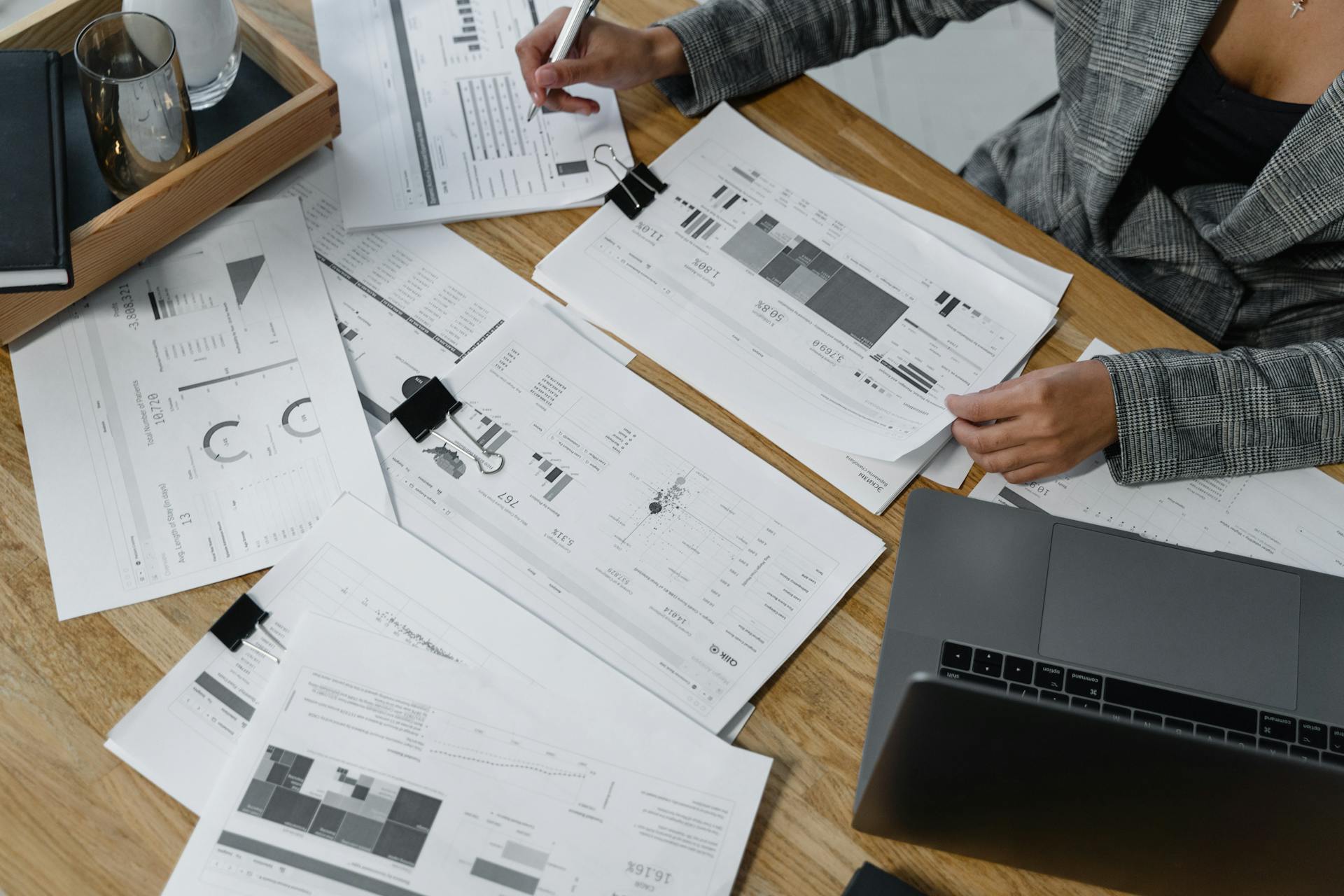
Depreciation expense on the balance sheet is a crucial concept for businesses to understand. It's the process of allocating the cost of a tangible asset over its useful life.
Depreciation expense is calculated using the straight-line method, which assumes that the asset loses value at a constant rate each year. This method is widely used due to its simplicity.
A tangible asset's useful life is typically between 5-20 years, depending on its type and usage. For example, a computer might have a useful life of 5 years, while a building might have a useful life of 20 years.
The depreciation expense is recorded as a contra-asset account, which means it's a deduction from the asset's original cost on the balance sheet.
Here's an interesting read: Balance Sheet and Cash Flow Statement
What Is
Depreciation is the decrease in value of a fixed asset over time. This happens due to physical and functional deterioration.
The cost of a fixed asset is initially recorded as an asset, not an expense. For example, a company might buy a machine for $30,000.
Physical depreciation occurs due to wear and tear, while functional depreciation happens when an asset becomes inadequate for its purpose.
Depreciation is caused by two types of deterioration – physical and functional. The value of an asset diminishes over time.
A fixed asset like a machine might be used for 5 years before its value decreases significantly.
Calculating Depreciation
Calculating depreciation is a crucial step in accounting for fixed assets on your balance sheet. You can use the straight-line method, which distributes the cost of the asset evenly over its useful life.
The straight-line method is the simplest and most common method. For example, if a company buys a delivery van for $40,000 that can be used for 5 years, the depreciation expense would be $8,000 per year.
To calculate depreciation using the straight-line method, you need to know the historical cost, residual value, and useful life of the asset. Historical cost includes the purchase price and all incidental costs of the asset, while residual value is the estimated value of the asset at the end of its useful life.
A unique perspective: Depreciation Expense Straight Line Method
The formula for straight-line depreciation is: Historical Cost – Residual Value / Estimated Useful Life. If there is no residual value, the formula simplifies to: Historical Cost / Estimated Useful Life.
Here's a breakdown of the variables:
- Historical Cost: Purchase price and all incidental costs of the asset
- Residual Value: Estimated value of the asset at the end of its useful life
- Useful Life: Amount of time the asset can be used (in months or years)
For instance, if the delivery van has no residual value, the depreciation expense would be $40,000 / 5 years = $8,000 per year.
Alternatively, if the delivery van has an estimated residual value of $10,000 after 5 years, the depreciation expense would be $40,000 - $10,000 = $30,000 / 5 years = $6,000 per year.
You can also use other methods to calculate depreciation, such as the double-declining balance method or the sum of the years' digits method. However, the straight-line method is the most common and easiest to use.
Here are some common depreciation methods:
- Straight-Line Method: Depreciation Expense = (Cost of Asset – Salvage Value) / Useful Life
- Declining Balance Method: Depreciation Expense = Book Value at the start of the year * Depreciation rate
- Sum of the Years' Digits Method: Depreciation Expense = (Cost of Asset – Salvage Value) * (Remaining Life / Sum of The Years’ Digits)
- Units of Production Method: Depreciation Expense = (Cost of Asset – Salvage Value) / Total Units Expected to be produced
Recording Depreciation
Recording depreciation is a crucial step in accounting for assets on your balance sheet. It's recorded by debiting Depreciation Expense and crediting Accumulated Depreciation.
Depreciation Expense is an expense account presented in the income statement, measured from period to period. It's recorded at the end of the period, usually monthly, quarterly, or yearly.
Accumulated Depreciation is a balance sheet account representing the accumulated balance of depreciation. It's a contra-asset account, presented in the balance sheet as a deduction to the related fixed asset.
To record depreciation, debit your Depreciation Expense account and credit your Accumulated Depreciation account. This is done at the end of each period, such as December 31st. For example, if the depreciation expense is $6,000, the entry would be:
Accumulated Depreciation is continually measured, so the balance is updated each period. For example, if the depreciation expense is $6,000 per year, the accumulated depreciation balance would be $6,000 in 2018, $12,000 in 2019, $18,000 in 2020, and so on.
The carrying value of an asset is the original cost minus any accumulated depreciation. It's essential to adjust the carrying value regularly to reflect the asset's depreciated value.
Take a look at this: What Is the Difference between Depreciation Expense and Accumulated Depreciation
Depreciation Schedules
A depreciation schedule is a crucial tool in financial modeling that helps forecast the value of a company's fixed assets, depreciation expense, and capital expenditures. It's required to accurately reflect the value of a company's assets over time.
To create a depreciation schedule, start by referencing sales revenue as the first line item, as it's a common driver for both capital expenditures and depreciation expense. This is the foundation of the schedule.
Below sales revenue, prepare a section for capital expenditures and reference historical CapEx from available periods. You can project future capital expenditures by using one of three forecasting assumptions: CapEx as a percentage of sales, a fixed recurring amount, or reasonable "hard dollars" expected to be incurred.
A depreciation schedule lists different classes of assets, the type of depreciation method they use, and the cumulative depreciation they've incurred at various points in time. It may also include historic and forecasted capital expenditures.
To summarize the depreciation schedule, prepare a breakdown of the net change in PP&E at the bottom. This involves adding capital expenditures, subtracting depreciation expense, and subtracting any sales or write-offs.
Additional reading: Accounts Receivable vs Deferred Revenue
Balance Sheet Accounting
Accumulated depreciation appears as a credit balance on the balance sheet, just under fixed assets. This is a contra-asset account, meaning it's a negative asset account that offsets the balance of the asset account it's associated with.
Accumulated depreciation is typically shown separately for each class of assets, such as furniture, equipment, vehicles, and buildings. For example, if a company wants to see the accumulated depreciation by asset type, the fixed asset section of the balance sheet might show separate lines for each class of assets.
Here's an example of how the fixed asset section of the balance sheet might look:
Accumulated depreciation is not a current asset, as current assets aren't depreciated because they aren't expected to last longer than one year.
Intriguing read: T Account Debit Credit
Where Does Go on the Balance Sheet?
Accumulated depreciation appears as a credit balance on the balance sheet, just under fixed assets.
In most financial statements, the balance sheet will show one line for accumulated depreciation on all assets. However, some statements may show accumulated depreciation separately for each class of assets.
Additional reading: The Normal Balance of the Accumulated Depreciation Account Is Debit
For instance, if a company wants to see the accumulated depreciation by asset type, the fixed asset section of the balance sheet might look like this:
The accumulated depreciation number on the balance sheet is the cumulative total of all depreciation that has been taken as an expense on the income statement from the time the company acquired the asset until the date of the balance sheet.
Suggestion: Balance Sheet Income Statement and Cash Flow
Is an Asset?
Accumulated depreciation is not a current asset, as current assets aren't depreciated because they aren't expected to last longer than one year.
Accumulated depreciation is a contra-asset account, which means it's a negative asset account that offsets the balance of the asset account it's associated with.
Contra-asset accounts, like accumulated depreciation, work in the opposite direction of standard asset accounts: credits increase its value while debits decrease its value.
Accumulated depreciation is typically shown in the Fixed Assets or Property, Plant & Equipment section of the balance sheet.
Readers also liked: Accounts Receivable Are Typically Classified as Current Assets Because
Frequently Asked Questions
What are the balance sheet entries for depreciation?
The balance sheet entries for depreciation involve debiting the depreciation expense account and crediting the accumulated depreciation account. This reduces the book value of the asset over time, affecting both the asset's value and the company's expenses.
Sources
- https://www.accountingverse.com/accounting-basics/depreciation-expense.html
- https://www.patriotsoftware.com/blog/accounting/what-is-accumulated-depreciation/
- https://corporatefinanceinstitute.com/resources/financial-modeling/depreciation-schedule/
- https://www.bench.co/blog/accounting/accumulated-depreciation
- https://redbeam.com/blog/fixed-asset-depreciation/
Featured Images: pexels.com


